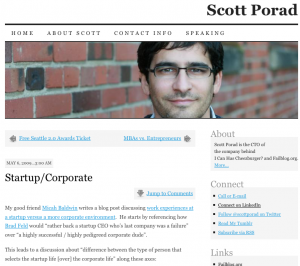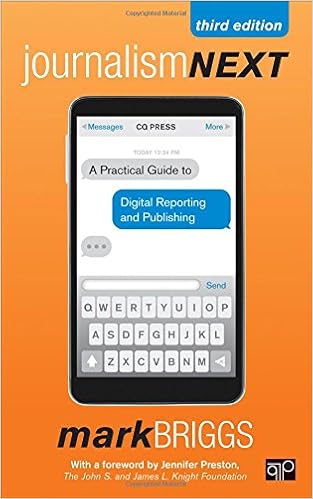 Scott Porad, the CTO of the company behind FailBlog.org and I Can Has Cheezburger?, highlights what hinders innovation at news organizations – and every other big company – in a recent blog post that actually made no mention of the news industry.
Scott Porad, the CTO of the company behind FailBlog.org and I Can Has Cheezburger?, highlights what hinders innovation at news organizations – and every other big company – in a recent blog post that actually made no mention of the news industry.
Some people view the world with rose-colored glasses. Mine are journo-colored, I guess.
So I immediately identified with Porad’s post, titled Corporate/Startup, and the contrast between working at corporate news organizations (which I did for 15 years) with working at a startup (which I’ve been doing for seven months now).
The discussion centered on the difference between the type of person that chooses to work at corporate jobs vs. those that are drawn to startup companies. Porad concludes that the balance between time spent doing vs. planning is the most significant determining factor. And I completely agree.
Over an 8 year period, my last startup grew from a startup into a corporate environment with several hundred employees and layers of management. For the last 5 or 6 years of that I felt like we spent 80% of our time planning and only 20% of our time doing stuff.
To me, this very frustrating. I enjoy just doing stuff, and I felt like all my time was spent discussing/debating/arguing with others about what we should be doing, instead of just doing stuff to see what worked. A lot of the time it felt like we were just paralyzed in planning…literally gridlock.
Frustrating, indeed. Anyone who works for a news organization (or other large corporation, for that matter) can weave tales of woe around all the planning, brainstorming, off-site retreats and other groupthinks that led nowhere. Isn’t it ironic that news companies, given a breaking news event, quickly break out of “paralysis by analysis” and move at breakneck speed to cover the news, print extra copies and provide bonus coverage on the air or online?
So here’s today’s “breaking news:” your business is in trouble. Stop planning and start doing.
Easier said than done, I know. Porad, who estimates that his current startup spends 5% of their time planning and 95% doing, pinpoints the difference between an established company and a startup when it comes to planning vs. progress.
I think the most important difference is that we have a very clear vision of what we want to do. This allows us to make decisions about what to work on quickly and easily. I always thought my old company was paralyzed because there wasn’t a very clear vision or plan or strategy. As a result, we couldn’t just do stuff was because nobody could even agree on the general direction that the stuff should be headed.
But, there were other reasons too: the company had a culture that was risk-averse and punished failure — success was the only option.
News organizations haven’t been able to transform from a perfectionist, command-and-control culture into a free-thinking startup, though many have tried through programs like The Learning Newsroom. So it’s time to break the problem into small, digestible chunks (which is another concept Porad wrote about recently).
How to bring a startup culture into the newsroom:
1. Divide and conquer: Pick 2-3 small teams and give them decision-making authority. In other words, allow them to launch anything the whole team agrees is worth trying. But pick the right people. Remember, there are certain types of people who prefer planning to progress. That’s not who you want.
2. We report, you decide: Use the weekly or monthly meetings that normally serve to seek clearance on new projects as a progress update. So instead of “we’d like your blessing to try this new approach,” the message would be “we are trying this new approach and this is what we’ve seen so far.”
3. Don’t let money stop you: If it’s a service that costs money, don’t waste time traveling up the chain of command to get approval. Either ask the vendor for a free trial (good service providers will be flexible, especially in this climate), or if it’s an online technology, look for an open source solution or find another news organization that will share some code.
Ryan Thornburg has been riffing on this lately, too. He argues that “innovation isn’t enough” and urges newsrooms to get past the idea of “innovation” and adopt a more defined experimentation approach. He even offers a “failure form” that can be used “by reporters and editors who want to pursue a crazy idea.”
Personally, I’m energized every day because with my startup company I can focus on progress ahead of planning. There were days when I was working in the newsroom when I’d come home and my wife would ask me how my day went. I’d stop and think for a moment and realize I did nothing but go to meetings and answer emails. So basically I had nothing to show for 9-10 hours of “work.”
Some people are OK with this. I’m just not one of them.
 Mark Briggs
Mark Briggs  Posted in
Posted in 




